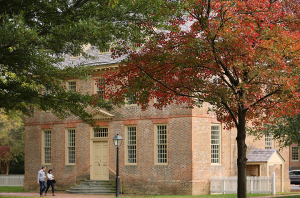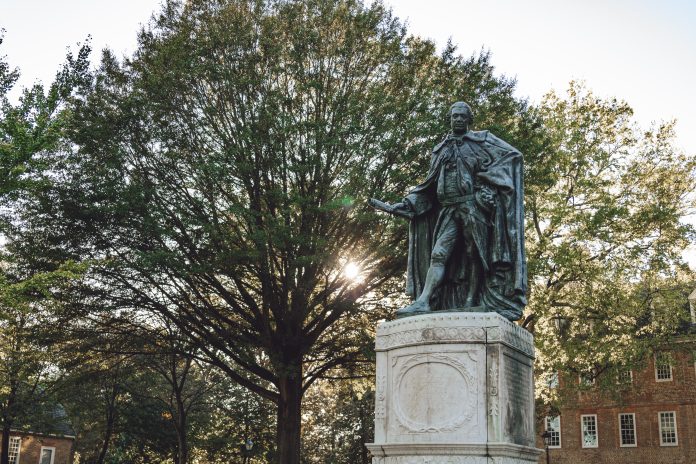From Nov. 9-12, the American Indian Student Association hosted “Brafferton Week” to commemorate American Indian contributions to the College of William and Mary. Through guest lecturers, open discussions and a movie night, AISA highlighted the legacy of Native people on the College’s campus, from discussion concerning the Brafferton Indian School to the present day.
AISA President Carolina Wasinger ’21 said the inspiration for Brafferton week came from a petition that circulated over the summer, calling for the removal of “Tribe” as the College’s athletic mascot. The petition cited the term “Tribe” as offensive to Native people. However, AISA members, like Wasinger, felt that this petition did not accurately represent their views.
“We kind of felt like we were being run over by non-Native voices who were speaking for Native people,” Wasinger said. “We wanted to further some initiatives that highlighted the Native presence on campus.”
In response to the petition, AISA posted a statement on their Instagram page, arguing that “Tribe” was not offensive and in fact represented the College’s ties to Native people.
“Native communities value self-determination because in the past, our people have been forcibly silenced,” the statement read. “We believe that keeping ‘the Tribe’ allows for us to hold William and Mary accountable to our legacy.”
As a further measure, AISA put out their own petition, advocating for greater student engagement with the history of Native people at the College.
“We used to make up such a large percentage of the student body at William and Mary,” Wasinger said. “We’re so important to the history of it. The finances and everything, a lot of that came from the Brafferton Indian School. We were really here since the school’s beginning, or a couple decades after the school’s beginning. So, it’s difficult to see that eroded over time, our legacy here.”
“We used to make up such a large percentage of the student body at William and Mary. We’re so important to the history of it. The finances and everything, a lot of that came from the Brafferton Indian School. We were really here since the school’s beginning, or a couple decades after the school’s beginning. So, it’s difficult to see that eroded over time, our legacy here.”
As part of this effort to highlight Native contributions at the College, AISA spearheaded Brafferton week, named after the Brafferton Indian School, which operated on the College’s campus from 1723 to 1779. Along with discussions hosted by Native students, AISA also hosted a talk by American Indian Resource Center Director Danielle Moretti-Langholtz, who recalled a time in the College’s history where Native imagery was removed without the approval of Native people.
In 2006, the College was forced to change its logo, which featured two yellow and green feathers, because the NCAA ruled Native American imagery as “hostile and abusive.” At the time, Moretti-Langholtz was asked by the College to speak with Virginia tribes and determine whether or not the feathers were truly offensive.
“I contacted every tribal organization, had conversations with them, I showed them this image, I told them the story about what was on the basketball court, and what were their thoughts,” Moretti-Langholtz said. “And their thoughts really surprised me. Every single tribe at that time, every tribal community said, ‘one, we don’t want any mascots. Two, feathers are not a mascot. Three, and most importantly, professor, your school has forgotten its association with Native people.’ That was a huge statement to deliver to the administration at William and Mary: ‘you’ve forgotten. And if you take the feathers away, you’ll really forget everything about us.’ That was my beginning of a 10-year quest to learn about the Brafferton.”
Despite the views of the Virginia tribes, the College changed its logo in 2007, following the NCAA’s ruling. Moretti-Langholtz’s story parallels that of the “Tribe” petition, where Native voices were suppressed in order to remove Native imagery or language. For students like Wasinger, these incidents tie into a larger trend of misunderstanding Native legacies on campus, starting with the Brafferton.
“I think there are some people who know there was an Indian school, and then they associate Indian schools with the Carlisle Indian School in Pennsylvania, where disease was rampant, where kids were really abused and really mistreated,” Wasinger said. “But this Indian school was something very different. It was something for the chiefs’ kids to go to and learn English so that they could work as translators. I think there are general misconceptions about what Indian education is, and that’s built in necessarily with the Brafferton.”

Moretti-Langholtz also urged students to consider the Brafferton’s nuanced legacy.
“This is something that we at William and Mary really need to understand,” Moretti-Langholtz said. “Yes, we had an Indian school, and no, I’m not celebrating that we had an Indian school. But I am saying, ‘let’s think about how our Indian school historically fits within the framework of all other Indian schools.’”
Moretti-Langholtz pointed out that although the Brafferton only had 10 to 20 students at a time, they made up a significant proportion of the student body in the 18th century.
“I think that has been lost on people,” Moretti-Langholtz said. “It wasn’t 5,000 students at William and Mary. Maybe there were 40 or 30 from the planter class, and 10 to 20 were also there, and they were American Indians. This is astonishing, and it puts an emphasis on our Native history in a much more magnificent story.”
Though the Brafferton had comparatively few students, Moretti-Langholtz emphasized that many students went on to have important roles in the College’s history and in the Revolutionary War.
“One of the students who went to our school, who was Cherokee, was a translator for Patrick Henry,” Moretti-Langholtz said. “Another student who went to our school, I have every expectation that I’m correct that he knew George Washington and worked for him. Another one was involved in espionage for the Americans.”
Along with Moretti-Langholtz’s talk, AISA sponsored a discussion with a Nansemond tribal member, who talked about his work with the Nansemond tribe and the connection between Virginia tribes and the College.
It seems like such a fragile topic, like, ‘oh, I don’t want to offend your history or your culture, as a white person. And a lot of things we’ve talked about is like, ok, well, there’s a difference between appropriation and support.”
“The Nansemond were very involved with the beginning of the Brafferton, so it was nice to see that William and Mary still has relations with those tribes from hundreds and hundreds of years ago,” Wasinger said.
AISA also hosted a “fireside chat” with residents of the Colonial Williamsburg house, a historical building owned by the College. The chat focused on contemporary Native culture and the experiences of Native students on campus. Sydney Hamrick ’21, one of the two residents of the Colonial Williamsburg house, emphasized the importance of listening to Native voices.
“It seems like such a fragile topic, like, ‘oh, I don’t want to offend your history or your culture, as a white person,’” Hamrick said. “And a lot of things we’ve talked about is like, ok, well, there’s a difference between appropriation and support. It’s ok to ask, ‘what tribe are you from?’ That’s not an offensive question. People want to talk about their tribes. Just talking to Natives and hearing their perspectives is so much better than guessing.”
Throughout the week’s activities, AISA urged students to understand the legacy of American Indians at the College. For Wasinger, this starts with raising awareness.
“If I said ‘the Brafferton,’ I feel like most people on campus wouldn’t know what that was,” Wasinger said. “But it’s the President’s office, it’s one of the oldest buildings on campus, it’s right behind Wren. It’s very central to our campus, so it’s kind of highlighting that more and making it more well-known and giving that information to folks. That’s the goal of this week: to make the campus more aware of Native presence, and then also make them more aware of the Native history and legacy of the school. That’s the idea behind Brafferton Week.”

